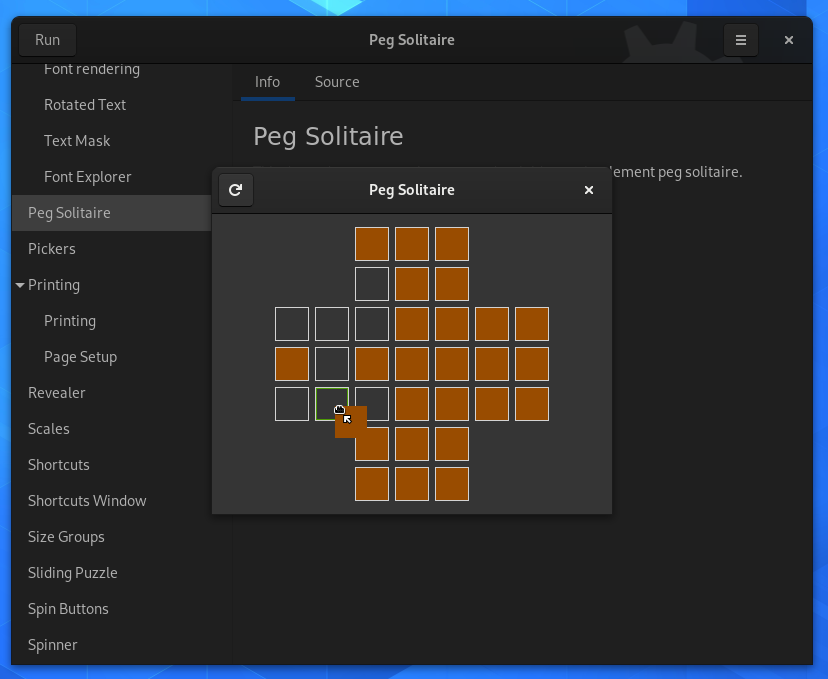People love PC case building competions and get to strut their stuff.
It also means they get to write a post with an animated GIF in it (of their design) and possibly a collada file from sketchup of their design. It would be so cool in Movm to be able to view a collada file of a 3D model, especially an interactive one you can click to see the lid open in an animation, or for the DVDRW drive to slide open too.

The old UK digital TV "Red Button" switch-over sucked and should have had an rj45 port and a small CPU and xvid h.264 instead of mpeg2. A mobile phone 25MHz cpu would have been something they could have added as a minimum so two-way interaction could have been had. Or even the RISC 68040 found in printers would do (and it would have provided decent IEEE for serial since the 68030, and parallel for the IEEE1284 in the 68040, such as the MC68040FE25V). Even blu-ray players with their ethernet port were better and had java (although frankly the non-foss nature of java is also bollocks and you had to write your own keyboard input back in the day, which was such bullshit).
Fortunately, it is very commonplace for people to build an HTPC these days. It usually leans towards XBMC which is kodi, and that at least means the hardware of an xbox (basically a 733MHz geforce3 akin to radeon 9200le underclocked, not far off an old raspberry-pi or gamecube/wii hardware spec), and this is good because it gives a known quantity hardware spec. At least 4GB of RAM is fair to expect these days, but what with DDR3 in AMD APU systems being so cheap, it would not be unrealistic to expect people to get optimal performance in a 16GB RAM set up. A real HDD should be assumed and that is because the xbox had one (and ideally a sata HDD is used and a sata DVDRW but booting from a USB-HDD is acceptable and a usb-DVDRW is acceptable however linux can complain about usb sometimes). It means swap space can be managed without worry about wearing out a NAND SSD (even if you also have one). Of course it also means files can be stored. It would be nice to also assume that users would have at least 6 or even 8 sata ports (either on the motherboard or added via HBA in a pci-e) to allow one sata-port to be for a DVDRW, another SATA port to be for that bootable Xbox HDD (which has a partition for files and another for swap space), but also, another 6 laptop HDDs of 1TB (4 for the array and 2 for index, thereby giving about 3TB storage) to be BTRFS solely for files (or games) and not the OS. However that would be optional extra, and the existence of all that RAM means files can be used in that (or "partitioned" into a fake HDD like a LiveCD ever since knoppix has done that, or even just debian). So I'd be happy with the assumption that there is always the DVDRW drive and 1 HDD, and so any other drives (like those btrfs) are optional extras but still a known-quantity. When kodi boxes came out on boxes lower in specification than an original xbox it really did defy the point of the known-quantity hardware. I cannot stand that. Somebody always has to mar a nice thing, don't they? Well the spec is now raised again, thankfully so those days are over.
This hyperlink has Movim mentioned with Kodi, so I figured it would make good information as an aside.
https://homehack.nl/page/2/
Movim in Kodi is needed, and (especially when a kodi HTPC has 3D capability which usually at least as good as an AMD HD3000 SMA graphics, or an APU such as on a 6400k CPU with APU, or a caicos hd6450) it needs some sort of WebGl 3D interaction (and using SimpleSAMLphp for OAuth2 with OIDC user registration is worthwhile too, possibly also using OpenCL in SciLab) so low bandwidth interaction can be had (such as 3D games with audio, or powerpoint style presentations with 3D similar in graphics quality to CS4 adobe-flash with papervision). A wii-remote should be the assumed controller because the driver is in the linux kernel and has been for about a decade, and a chatpad (e.g. qwerty) could be added. The above hardware spec (if the btrfs is there) blatantly allows for IPFS to be added so people can actually have a decent video network in Standard-Definition (about bitchute quality as DVD quality like an old XBOX, or at most 720p). But really 3D assets would be the great thing.
https://neverwintervault.org/cep
In the game NeverWinterNights, there was a "community expansion pack". A known quantity expansion pack of sound samples, textures and 3D models about the quality of a gamecube graphics would mean it would be possible for small collada file animations and games like a blender3D or sketchup would be able to be made for everybody even on a low-bandwidth (1 megabit) connection because everybody would already have the "CEP" community expansion pack (presumably released in an ISO file the size of a 4GB DVD, so that if you cannot download it, you can just copy a DVD from your friends, and a hashfile or magnet link checks it is legit). Actually the Movim CEP ISO should be merely 3.5GB so that it could also go on a crap SDCard where they skimp and don't give you the full 4GB. It would be cool if (when the user chooses the "yes/no" tickbox option) the torrent file of this MovimCEP.iso (full of approved public-domain 480p video clips, 3D model collada files, textures, sounds etc.) could be grabbed during installation like wubi.exe used to do, and then the HTPC could serve it to others who need it. In the apocalypse, you'd always get your movim htpc setup.
To be honest, even a dual-ISDN connection would probably be usable as a bandwidth, but 1megabit is a nice easy number and is also the upload speed of a ADSL connection (not ADSL2) in the UK, and after all a HTPC tends to sit under the TV set and can be plugged into a home internet connection. At worst a 3G simcard in a router (as a contingency) would be providing about a third of a megabit (300Kbps), and even that is enough, but 1 megabit is safe to assume in general because the cable comes out the wall.
So I think a (half-height matx) HTPC BOX for Movim should be designed by the community (public domain style) sort of like a competition (except you don't win anything - lol). It would of course be able to take the sata 3.5 inch HDD in the style of an XBOX, and a sata 5.25 inch bay DVDRW drive, standard tray loader, and space for 6 sata laptop HDD drives in case people want the BTRFS. It should take a standard ATX PSU, because a PSU is a pain in the arse if it blows. A minimum 300watt bronze rated PSU could be assumed. I think that is a fairly humble PSU Wattage standard. The HTPC case should also have the ability to be seen (by the human standing or sitting infront of it) as an oblong box with 4 InfraRed recievers (one on each corner) so that the wii remote can work (and bluetooth would be assumed, and that could be bluetooth 2.1 with A2DP). A wifi of both 802.11g and 802.11n should be assumed (but you must be able to turn it off if security is a worry, and so the ethernet can be used instead as default). If the HTPC has additional hardware ability such as better bluetooth or wifi (such as bluetooth4 or 802.11ac then that is fine and I don't care or mind but it must have the aforementioned minimum). It should also have two rj45 ethernet connections at 1GBPS each and I don't care how they are implemented. You could use the onboard rj45 and a usb rj45 dongle combined for all I care. I don't think assuming a person has a ethernet dell i350-t2 is fair (and btw those get faked too often), but it could be an optional extra. Likewise a 8core CPU (Ryzen 7 4700U) could be an optional extra for those who want blake2sp with their btrfs array of 6 sata 2.5 inch HDDs. But realistically, it cannot be assumed as a spec people will own and that is because it is just too expensive and we do not want this to be a "toy for the rich". Having a cheap (at most £10) dual-core A6-6400k using the onboard APU and not dual-channel RAM is reasonable (and people can discover the CPU is very overclockable to 4GHz or even 5GHz if they are truly bothered, and the APU uses little power). But really, the dual-core performance of 3.9GHz is a lot of CPU power, and you could even run docker on one core (even if it is inefficient). This low-spec is enough to get a decent opengl4.4 standard, and can allow for "dual-graphics" (if Microsoft Windows is perhaps chosen and not just Linux) if somebody wants to use a HD6450 with it, or even two in crossfire if they have a motherboard that can do that. The assumption that is that the HD 8460D APU is used (with a minimum 256 megabytes of RAM dedicated to graphics in the BIOS) and without dual-channel RAM. And so that is slow by modern standards but you can still do a lot with it (but if a person has lots of RAM like say between 6GB and 16GB they may wish to dedicate 2GB RAM to the onboard graphics APU as some DirectX11 games or OpenGL games need that, like FarCry2, if a person uses the HTPC also for 3D of that standard even just on low settings when using 3D beyond gaming, although they might also wish to do some humble gaming on the PC too with it). The point is to avoid making it difficult for people. Allow them to have unoptimised systems so at least that have something that works good-enough. The spec is so low that, not only can people often buy it, some people would even give such things away as gifts. The other useful thing about this is that, even if a person has a motherboard with poor expansion options for PCI slots, such as the ASUS a68HM-plus, they still have the PCIe x16 Gen2 slot and a PCI-e x1 Gen2 slot and one PCI-legacy slot. So perhaps one day fast network adaptors in the PCI-e x16 slot (such as an infiniband) become more abundant and they can use that. Or maybe a HBA becomes more abundant so as to put in a great many HDDs. Meanwhile the PCI-e x1 gen2 slot can be used to add two more sata ports so a total of 6 HDDs can be added since the motherboard has 4 sata ports. The legacy PCI slot could be used for IDE pata or sata to add a couple of ports to make 8 sata ports available.
It should be assumed that, if the PCI-e x1 slot is used to add two sata ports, this chipset of HBA is used (and this video by Mark Furneaux shows how other chipsets on HBA such as marvell might otherwise fail):
Mark Furneaux video of ASM1061 HBA
Detailed Look At A $6 ASM1061 SATA HBA From eBay
https://www.youtube.com/watch?v=yqQPh8KZhp4
There should be an option for people to boot the Operating System off the parallel port (although it would not be the standard). This also means a parallel port dongle (such as a SDCard reader-writer parallel port adaptor) could be used. It would be acceptable for a Raspberry-Pi GPIO to be used to connect to the parallel port if needed, or just a usb-parallel port adaptor plugged into some other raspberry-pi such as a pi-zero. An extra design for an arduino based (atmega32) chip could be made (vaguely like a lallafa plipbox, but not ethernet) to plug into the parallel port, allowing an SDCard of say 8GB to 32GB to be read to and written to (but preferably a real HDD could be plugged in via sata or IDE in the parallel port dongle so swap space could be used albiet very very slow). It just means the maximum can be squeezed out of the other sata ports (such as 6 sata if the 2port ASM1061 HBA is added) for btrfs without the OS interfering. That optional extra is only for people who want it though. I've always had a thing for booting from a IEEE1284 port ever since 6x speed CDROM (CDRW) drives were a thing as ECP. I cannot resist adding it as an optional extra. You can boot off a parallel zipdisk drive for all I care (in "emergency mode").
People should be able to make their own Movim-HTPC-KODI-PC-Case with tools no more exotic than A4 Paper black-and-white printer templates (pdf), a reciprocating saw (sawzall), a pair of tin-snips, and very humble dremel (or clone rotary tool) and an electric drill and a cheap carbon-steel tap-and-die set. So it would seem likely that Aluminium and thin sheet metal would be materials used, and motherboard stand-offs. No 3D-Printer should be "required". This HTPC must be able to be made poor-man style. Try to keep adhesives simple such as commonly available 2part epoxy-resin and gorilla-glue and contact-adhesive and maybe silicon adhesive if heat is a worry. I think also 2part metacrylate adhesive (while a bit exotic) would be just about "fair" as an adhesive to use because the use of acrylic panels is fairly commonplace in a PC case (if needed). The case could include commonplace sheet metal but even occassional cheap metal (for pic-e blanking plates and) could be made from old tuna tins (cleaned of course). It would make sense to try to use mild steel where possible because paint is cheap. Paint for aluminium can be pricey and that is not so desirable a factor. Extremely cheap parts can be used where possible, but a nice paint job from a spray can can make it look smart. Yes I honestly would use tuna tin metal for PCI blanks.
So yeah, there is no prize. Just use the hashtag #KodiMovimCase so people know what your movim post is about. Mind you, one "prize" is that people would be able to use their Movim Kodi boxes to access content at least as good as my amazing post I have written here (and with 3D graphics somehow). I might make a proper list of criteria but frankly, this post has all the information needed. I am assuming vanilla debian would be a default Operating system even though I'd like slackware and OpenIndiana options to exist, but basically, it would be down to the nature of KODI's most commonly chosen kernels (rather than me getting what I want). I really like the idea of the legacy PCI slot having a terratec ews88mt sound card being plugged in to people can start to use the box for good content creation, in a full-height version. It would mean decent linux drivers get written for that old card in slackware (or even OpenIndiana), but that will need to be another "optional extra" and it would require a full height case (which I am trying to avoid so as to keep the HTPC slim). The PC case being slim also increases the chance of a person putting it in their living room (lounge) where it can be seen, and so the four InfraRed (probably usb IR) recievers can be seen on the 4 corners and used with the wii-remote. Also two playstation3 (720 pixel) usb web-cameras should be able to be plugged in with one on each corner. This means that a 3D stereoscopic image could one day be made in software. So even if just one camera gets used (and after all both can be unplugged if privacy is a concern), it means the PC case has potential for usage with the Movim XMPP video conferencing in future. I imagine what people would do is decide that, even though their own MovimKodiCase must conform to fit the asus a68hm-plus motherboard (which is FM2), that they will have their own desired hardware spec so that they, for example, have a matx motherboard taking something similar in speed such as an am3 socket Athlon II x2 220 Chip and a HD6450 (or r5 230), and then one day they decide to upgrade the CPU to a fx8350 and the GPU to a rx570. That is fine to do, just as long as the previous motherboard FM2 asus a68hm-plus can fit in for everybody else. It probably will mean that people submitting designs will choose two designs whereby one is a half-height and the other is a full height (so they can put their new graphics cards in). In that situation, mark your movim post with the additional hashtags #MovimKodiCaseFull and #MovimKodiCaseHalf also.
One last thing, the movim KODI HTPC should expect the user to be able to plug in a Realtek RTL2832U for digital TV. They are £10. If SDR Software Defined Radio is used through such a dongle, well that might be a thing too. Apocalypse reasons. The MovimHTPC would of course be able to be used worldwide. So yeah those are my specs. You may suggest other spec but the chances are this comment will be the final word on the bare-minimum specification because a line has to be drawn somewhere. And yes I know, I too would love 8core minimum for btrfs and better instruction sets and a Radeon rx570 but we have to be realistic. This should be something easy enough that people make them for cheap and give them to a friend or three as gifts. Until the battle of vulkan and OpenGL4.5 and Directx12 is won (with at least 3 versions coming out), this old OpenGL4.4 (if the HD6450 is added, and it probably would be that matx Asus a68hm-plus motherboard that gets used, but you may squeeze in a different motherboard model as long as the case also works with the a68hm-plus) should be used for many years. You do after all get the ability to have two monitors. That could mean one is for the TV screen and the other is a kiosk touch-panel or handheld touchscreen. It would be nice to imagine people would one day have the option to use their a6-6400k machine as a movim "pod" in addition to it running Movim as standard and Kodi (because eventually people would expand from 4GB and stick the 16GB RAM in). Maybe even some sort of IPFS gets flung in to use that 2TB of that btrfs array of HDDs. Digitally communicating over that SDR might be a nice thought experiment.
Link to a HTPC by a Movim user
chevron_right
 Starting in the early part of the last decade, large numbers of technically-minded individuals began selling piracy-configured set-top boxes to the public.
Starting in the early part of the last decade, large numbers of technically-minded individuals began selling piracy-configured set-top boxes to the public.

 In recent years, legal video streaming services such as Netflix, HBO and Amazon have flourished.
In recent years, legal video streaming services such as Netflix, HBO and Amazon have flourished.







